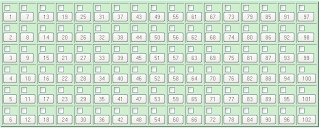Introduction to Prime Factorization chart fractions:
A Prime Number is a complete number, larger than 1, so as to can be evenly divided just by 1 otherwise itself. "Prime Factorization" is established which prime numbers require to multiply as one to obtain the original number.
A few of the prime numbers are: 1,7,13,19 etc...
The prime factorization of a digit is multiplying prime factors of a digit.
For example
38 = 2x19
Basic Prime Factorization Chart Fractions:
Factors:
"Factors" are the facts you multiply mutually to obtain another number: 45 = 3x3x5. In prime factorization, every factor will be prime numbers.
Example:
39 = 3 x 13 (use chart to verify the answer)
Here multiplication of 13 x 3 is called as prime factorization.
Example Problems for Prime Factorization Chart Fractions:
Problem 1:
What are the prime factorization chart fractions of `1/16` ?
Solution:
It is best to create work with the least prime number, which is `1/2` , so let check:
`1/16` ÷ `1/2` = `1/8`
But `1/8` is not a prime number, so we need to factor it further:
`1/8` ÷ `1/2` = `1/4`
But `1/4` is not a prime number, so we need to factor it further:
`1/4` ÷ `1/2` = `1/2`
`1/2` ÷ `1/2` = `1/1`
And 1 is a prime number,
`1/16` = `1/2` × `1/2` × `1/2` × `1/2`
All factors are a prime number, so the answer should be correct.
The prime factorization of `1/16` is `1/2` × `1/2` × `1/2` × `1/2`
Problem 2:
What are the prime factorization chart fractions of `1/150` ?
Solution:
It is best to create work with the least prime number, which is `1/2` , so let check:
`1/150` ÷ `1/2` = `1/75`
But `1/75` is not a prime number, so we need to factor it further:
`1/75` ÷ `1/5` = `1/15`
But `1/15` is not a prime number, so we need to factor it further:
`1/15` ÷ `1/3` = `1/5`
`1/5` ÷ `1/5` = `1/1`
And `1/1` is a prime number,
`1/150` = `1/5` × `1/5` × `1/3` × `1/2`
All factors are a prime number, so the answer should be correct.
The prime factorization of fractions `1/150` is `1/5` × `1/5` × `1/3` × `1/2`
A Prime Number is a complete number, larger than 1, so as to can be evenly divided just by 1 otherwise itself. "Prime Factorization" is established which prime numbers require to multiply as one to obtain the original number.
A few of the prime numbers are: 1,7,13,19 etc...
The prime factorization of a digit is multiplying prime factors of a digit.
For example
38 = 2x19
Basic Prime Factorization Chart Fractions:
Factors:
"Factors" are the facts you multiply mutually to obtain another number: 45 = 3x3x5. In prime factorization, every factor will be prime numbers.
Example:
39 = 3 x 13 (use chart to verify the answer)
Here multiplication of 13 x 3 is called as prime factorization.
Example Problems for Prime Factorization Chart Fractions:
Problem 1:
What are the prime factorization chart fractions of `1/16` ?
Solution:
It is best to create work with the least prime number, which is `1/2` , so let check:
`1/16` ÷ `1/2` = `1/8`
But `1/8` is not a prime number, so we need to factor it further:
`1/8` ÷ `1/2` = `1/4`
But `1/4` is not a prime number, so we need to factor it further:
`1/4` ÷ `1/2` = `1/2`
`1/2` ÷ `1/2` = `1/1`
And 1 is a prime number,
`1/16` = `1/2` × `1/2` × `1/2` × `1/2`
All factors are a prime number, so the answer should be correct.
The prime factorization of `1/16` is `1/2` × `1/2` × `1/2` × `1/2`
Problem 2:
What are the prime factorization chart fractions of `1/150` ?
Solution:
It is best to create work with the least prime number, which is `1/2` , so let check:
`1/150` ÷ `1/2` = `1/75`
But `1/75` is not a prime number, so we need to factor it further:
`1/75` ÷ `1/5` = `1/15`
But `1/15` is not a prime number, so we need to factor it further:
`1/15` ÷ `1/3` = `1/5`
`1/5` ÷ `1/5` = `1/1`
And `1/1` is a prime number,
`1/150` = `1/5` × `1/5` × `1/3` × `1/2`
All factors are a prime number, so the answer should be correct.
The prime factorization of fractions `1/150` is `1/5` × `1/5` × `1/3` × `1/2`
